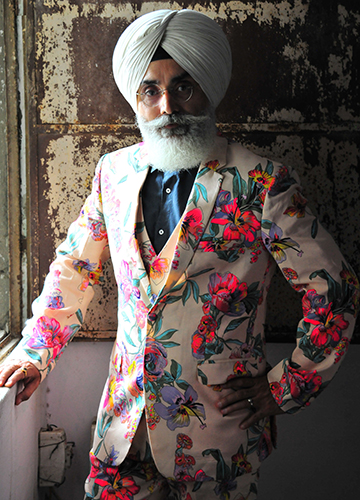If one were to browse through the riotous clothing line of Delhi-based fashion designer Param Sahib, they would know it is not for the lily-livered. His unisex shirts are often firework-themed, printed as they are with kitschy images drawn from boxes of Diwali firecrackers; sometimes they pay homage to video games from the 1990s like Super Mario Run, and at other times they are splashed with pops of Tazos plundered from packs of chips in school.
Param’s self-portraits often show him sporting a flower-fringed patka paired with African beadwork. Be it at the Hyatt Regency in Ludhiana or the India Couture Week at Taj Palace in Delhi, Param is dressed rainbow popsicle, with Insta followers often passing snide remarks like, “Have you ever tried tying a proper dastar?”
The Sikh turban or dastar has balanced tradition and modernity over the years, making its fashion-savvy adherents declare their simultaneous allegiance to spiritual and secular identities. Param dreams in technicolour. A Sikh fashion blogger and influencer, he easily blends his religious identity with trippy, youthful designs. “Now my community is more accepting of fashion. Initially, I would get lashings and threats like, ‘This is not how a Sikh man should be’,” says Param, who started his clothing brand around two years ago. While he agrees that changing beauty standards and inclusivity drives have made the Indian fashion industry more accessible, one would be hard-pressed to find Sikh models on the runway. “Usually turbaned male models are seen when the designers want a certain look, or they are friends with a celebrity designer,” says Param, at his warehouse in Noida. He believes restrictive social milieus and patriarchal codes still do not allow greater sartorial self expression among initiated Sikh women in India.
Traditional women’s fashion in the community has been defined by phulkari work across Punjab to celebrate family bonds and female friendships. Their designs have been altered to suit the tastes of changing times and appear in a dazzling array of embroidery work on kurtis, patialas, salwar kameez, shawls and even juttis. Women also improvise with keski or chhoti dastar. Something like Sikh Ladies in Sick Fashion, a fashion illustration series by Baltimore-based Jasjyot Singh Hans, vividly portrays curvy Sikh women with long, uncut hair—sometimes plaited, often let loose—screams body positivity, self-love and experimental fashion. His illustrations reclaim the natural selves of Sikh women in high-end designer labels. “After I moved to the US, I was surprised by how few people knew about Sikhism. Seeing the lack of representation of Sikhs in contemporary work culture, I started to consciously draw women that are Sikh,” says Jasjyot, who began his career with fashion illustrations for ace designer Sabyasachi Mukherjee, after studying at the National Institute of Design and the Maryland Institute College of Art. Food, music, books, colours, mood, people, all inspire his art when it comes to celebrating Sikh women.
Most hip headliners from the world of Sikh fashion are stationed in the west. From Waris Ahluwalia to Singh Street Style’s Pardeep Singh Bahra, who started his fashion blog to raise awareness about Sikhs post 9/11, after the world saw Osama Bin Laden in turban and beard. And from Karan Kaur, Australia’s first female turbaned, fashion blogger, to Harnaam, British Sikh model and campaigner who entered the Guinness World Records in 2016 as the first female with a beard to walk the London Fashion Week.
Delhi-based Jagjit Sabharwal, who calls himself a bizarre sardar on Instagram, wants to change the narrative. He once had practically nothing in his favour other than a long-abiding passion for style and fashion since college. He wanted to be a model and see his face on big hoardings, before he allowed more practical life decisions to take over. So, he studied engineering, worked in companies like Xerox and Tata Indicom, and later partnered with his friend to import electronics. At 42, he realised he was overweight and completely white-haired. He started running to get into shape and began colouring and cutting his hair and beard to closely resemble a model. Soon he realised his naturally grey hair was a boon. “My friends asked me, how many Sikh models have you seen? You will not get an opportunity. And then I realised that is the biggest opportunity I have,” says Jagjit, who transformed himself into a grey Sikh model. The 48-year-old Jagjit now struts around like a strapping old villain in TikTok videos and Instagram. “Frankly—and I am not boasting—wherever I go, even in metros and markets, people stare and start taking pictures,” he proudly declares. A fitness freak with a love for body-building, Jagjit has collaborated with multiple brands to offer his sturdy, dapper sardar look. And he is encouraging his 16-year-old daughter to be as fashion conscious as himself. “What is wrong in looking good? Carry yourself in the most dignified, stylish way you can.”


